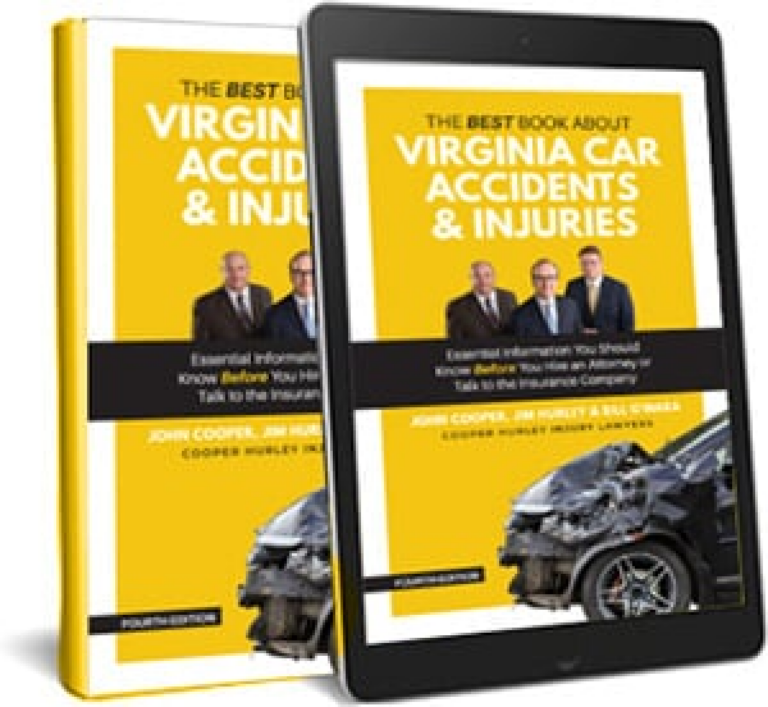Virginia Beach Personal Injury Lawyer
Have you recently been injured in an accident in Virginia Beach? You may be entitled to a substantial monetary award to help cover the costs of your medical treatment, loss of income, and emotional distress.
Our top-rated Virginia Beach personal injury lawyers have won millions of dollars in cases involving car accidents, truck accidents, brain injury, wrongful death cases, and other acts of negligence. Now we’re ready to help you stand up and fight for the money you deserve.

On This Page
- Why Work with Cooper Hurley Injury Lawyers After an Accident in Virginia Beach?
- At Cooper Hurley Injury Lawyers, Personal Injury Law Is All We Do
- Types of Personal Injury Cases We Handle
- What Does a Personal Injury Lawyer in Virginia Beach Cost?
- What’s My Virginia Beach Personal Injury Case Worth?
- What Do I Have to Prove to Win my Virginia Beach Personal Injury Case?
- When Should I Hire a Virginia Beach Personal Injury Attorney?
- How Long Will My Personal Injury Case Take? Will It Go to Trial?
- Experienced Virginia Beach Personal Injury Lawyers Ready to Fight For You
Why Work with Cooper Hurley Injury Lawyers After an Accident in Virginia Beach?
After an accident in Virginia Beach, the insurance companies certainly won’t have your best interests at heart. They’ll fight you at every turn, working hard to deny your claim or convince you to accept way less money than your case is worth.
That’s why hiring an experienced Virginia Beach personal injury lawyer is one of the smartest moves you can make after you or a loved one gets hurt.
At Cooper Hurley Injury Lawyers, Personal Injury Law Is All We Do
We have decades of experience handling complex personal injury cases in Virginia Beach and navigating our state’s unique laws. We only handle personal injury cases, and our only focus is helping those injured through no fault of their own. At Cooper Hurley Injury Lawyers, we’ve built our careers fighting on behalf of clients just like you.
Here’s why you’ll want our Virginia Beach personal injury attorneys in your corner:
- 120+ years of combined experience
- AV-rated by Martindale-Hubbell
- Millions recovered in financial settlements and jury awards
- Record-setting results, including the 5th highest settlement in Virginia in 2023
- Successfully litigated jury trials in federal and state courts
- Nationally recognized as Super Lawyers, Top 100 Trial Lawyers, Lawyers of Distinction, and Top Lawyers of Coastal Virginia
Our client satisfaction can’t be beaten because we genuinely care about the people we represent. We know that your life has been turned upside down because someone else was careless, and it’s our goal to help you make things right.
Types of Personal Injury Cases We Handle
At Cooper Hurley Injury Lawyers, we proudly advocate for clients in all types of personal injury cases in Virginia Beach, including:
Give our skilled legal team a call to discuss the specific details of your case. We’ll listen to your side of the story, answer your most pressing questions, and offer preliminary guidance about your legal rights and options. If you decide to move forward, our Virginia Beach personal injury lawyers will be ready to develop a strategy, perform a prompt investigation, and fight to get you maximum compensation.
What Does a Personal Injury Lawyer in Virginia Beach Cost?
There are no upfront or out-of-pocket costs to hire the Virginia Beach personal injury lawyers at Cooper Hurley Injury Lawyers.
We know that money can be tight after an accident because of medical bills and time missed from work, which is why we represent Virginia Beach accident victims on contingency.
You Only Pay if We Win.
When we win, our fee comes right out of your financial award. No win, no fee. Guaranteed.

ASK THE CAR CRASH EXPERTS
Jim Hurley, Personal Injury Lawyer
“The great thing about what I practice in personal injury law is that there’s no upfront cost. You can call us, talk to us, and there’s no cost. If we go ahead and help you with your injury from a car wreck, any cost associated with that, like investigation, getting medical records, having to pay doctors to chat with them, expert witnesses, things like that, we advance all that money. So, there’s no out-of-pocket money whatsoever. We do get paid when you get paid, so at the end of the day, our fee is based on the recovery, and we do get our costs back. But the nice thing is, initially, no money out of pocket by you. We do everything to help you, and there’s no advanced money out of pocket. It’s great for you.”
What’s My Virginia Beach Personal Injury Case Worth?
It’s hard to say how much money you might be able to recover after an accident in Virginia Beach without knowing the specific details of your case. After all, every accident—and every victim—is unique.
However, numerous factors can be helpful in assessing the potential compensation for a personal injury claim:
- What types of injuries did you suffer?
- Will you suffer from a permanent impairment or disability?
- Did you fully recover? If so, how lengthy was your recovery?
- How long will you have to miss work to recover from your injuries?
- What’s the difference between your earning capacity before and after your accident?
- Do you require assistance performing everyday tasks like bathing, walking, or driving?
- What out-of-pocket expenses have you incurred because of the accident?
- Did you contribute to the accident in any way?
- What type(s) of insurance coverage or benefits are available?
- How old were you at the time of your accident?
- What have the emotional and psychological repercussions of the accident been like?
- Did you suffer any scarring, deformity, or amputation from the accident?
The answers to some of these questions will sometimes not be known immediately after an accident. The more your life changes and the more catastrophic your injuries are, the more you can generally expect to recover in a related claim for damages.
The attorney you choose can also have a huge impact on your case. Hiring the right Virginia Beach personal injury lawyer could be the difference between getting a mediocre settlement and receiving fair and just compensation after suffering injuries through no fault of your own.
At Cooper Hurley Injury Lawyers, we’ve helped our clients win millions of dollars in settlement and jury awards, including multiple seven-figure results.
Notable Settlements for Cooper Hurley Injury Lawyers Clients Include:
- $6.5 million car accident settlement
- $5.8 million traumatic brain injury settlement
- $5 million construction accident settlement
- $4.725 million car accident settlement
- $2.86 million drunk driving accident settlement
We advocate fiercely for each and every client we represent, working hard to make sure their stories are told and they’re given every opportunity to get the settlements they deserve. Call our Virginia Beach personal injury lawyers to learn more about what your case might be worth and how we can help you achieve the best results.
What Do I Have to Prove to Win my Virginia Beach Personal Injury Case?
Generally speaking, personal injury cases in Virginia Beach are based on the tort of negligence.
Negligence, in very simple terms, means that someone acted unreasonably under the circumstances and, as a result, caused another person’s injury or death.
When you file a personal injury or wrongful death claim or lawsuit, you’ll have the burden of proving that someone else was negligent and, therefore, legally responsible for your injuries, harms, and losses. The at-fault person or business is known as the defendant in a personal injury or wrongful death claim or lawsuit.
To prove negligence, you must establish the following:
- The defendant owed you a duty of care.
- The defendant breached the duty of care owed to you.
- The defendant’s actions were the direct and proximate cause of your injuries.
- You suffered damages as a result.
Each element must be proven by a preponderance of the evidence, which is the burden of proof in personal injury cases. A jury has to believe that your side of the story is more likely true than not.
To prove who is at fault, you must have facts and evidence to support your claim. Depending on how and why you got hurt, helpful evidence might include the following:
- Photographs of the scene of the accident, property damage, clothing, and physical injuries
- Video footage of the accident
- Witness statements and testimony
- Expert testimony
- Medical records
- Accident reports/police reports
- Maintenance records
You don’t have to take on the burden of proving your personal injury case on your own. The experienced litigators at Cooper Hurley Injury Lawyers are here to take on that burden for you.
What if I am Being Blamed for My Accident?
If you were partially or entirely responsible for your accident, you will not be able to receive damages due to Virginia’s contributory negligence laws. Unlike jurisdictions employing a comparative negligence system, where damages are apportioned based on each party’s degree of fault, Virginia’s contributory negligence rule is more strict. If the injured party is found to have contributed, even minimally, to the cause of the accident, they may be entirely barred from seeking compensation from the at-fault party. This all-or-nothing approach means that a plaintiff’s claim can be entirely dismissed if any level of contributory negligence is established.
This also means that insurance companies or other at-fault parties may try to blame you for the accident to avoid paying for the accident, but they must have evidence to back up these claims. At Cooper Hurley Injury Lawyers, we’ll fight for you to ensure you’re not wrongfully blamed for an accident that wasn’t your fault.
Is There a Cap on the Amount of Damages I Can Earn?
In most cases, the state of Virginia does not impose a cap or limit on the amount of economic and non-economic damages you can earn in a personal injury case, though there are a few exceptions. For example, if you were injured due to the negligence of a doctor or other medical professional, those medical malpractice cases do have a cap on damages. Additionally, punitive damages in most cases are capped at $350,000.
When Should I Hire a Virginia Beach Personal Injury Attorney?
The sooner you get a jumpstart on your personal injury case, the better.
Critical evidence can get lost, destroyed, or forgotten as time goes on. Witness memories will begin to fade and change almost immediately. The link between the accident and your injuries will become less and less clear.
By calling an experienced personal injury lawyer in Virginia Beach immediately, we can launch a prompt investigation into your accident and work to preserve the evidence that may be critical in building a compelling case on your behalf.
It’s also important to note that you won’t have unlimited time to file a lawsuit after an accident in Virginia Beach. A two-year statute of limitations applies to most personal injury and wrongful death cases.
Two years might seem like a long time, but it can go by before you know it. You’ll lose the right to demand compensation if you miss the deadline that applies to your case. It is not unusual for an insurance company to drag its feet in making you a settlement offer or to wait many months before tell you that it is denying your claim and refusing to settle. These insurance company tactics can put you in a time-crunch if you do not have the assistance of a personal injury lawyer.
Protect yourself by making one simple call after your accident in Virginia Beach. The legal team at Cooper Hurley Injury Lawyers is available to help 24/7/365.
How Long Will My Personal Injury Case Take? Will It Go to Trial?
Every case is different. Most personal injury cases are resolved through a private settlement. Roughly five percentage of lawsuits end up going to trial. While a small percentage of cases go to trial, before an insurance company will pay fair money on a case it must be convinced that your lawyer is experienced and capable of taking your case the distance. This is why having experienced lawyers who only handle personal injury cases can be an advantage.
Cases that settle tend to resolve more quickly than cases that go to trial. Many things could influence how long it takes for your case to resolve:
- The severity of your injuries
- How long it takes for you to reach maximum medical improvement
- Whether liability or fault is contested
- Valuation of damages, particularly non-economic awards like pain and suffering
Keep in mind that a quick result isn’t always the best result. Once you agree to settle, you waive your right to any future compensation related to your case. That means you’ll be out of luck if your injuries are more serious than you originally expected , or it turns out that your case is worth way more than you initially thought. Our goal is to move as quickly as possible for you, but we also want to be sure your damages are fully considered. We will discuss your goals and current condition, and we will work together on the best approach for you.
Our personal injury lawyers in Virginia Beach will aggressively pursue compensation so that you’re awarded an amount that accurately reflects what your case is worth. We will never advise you to accept an unreasonably low offer. If we believe you deserve better, we’ll be ready to go to court and argue your case passionately before a jury of your peers.

ASK THE CAR CRASH EXPERTS
Jim Hurley, Personal Injury Lawyer
“Clients often ask, ‘Am I going to have to go in front of the judge? Am I going to have to go in front of a jury?’ The majority of cases do settle, but at Cooper Hurley Injury Lawyers, we believe they settle because we’re ready to go to court. We’re ready to go in front of the jury, we’re ready to go in front of the judge. But the vast majority of cases do settle because the insurance company knows that we are ready to go to court for you, to get you the best possible result based on your injuries and the sheer inconvenience you’ve suffered.”
Experienced Virginia Beach Personal Injury Lawyers Ready to Fight For You
Someone else caused you to get hurt. They have to be held fully accountable for the injuries and harm they’ve caused. Cooper Hurley Injury Lawyers can help you make that a reality.
Our Virginia Beach personal injury lawyers have dedicated their careers to standing up to powerful adversaries and insurance companies on behalf of deserving clients like you. For years, we’ve forced insurance companies, corporations, and other powerful adversaries to take our clients’ cases seriously and pay up, to the tune of millions in settlements and verdicts.
We’re the award-winning trial lawyers you’ll want fighting for you. Call our law office in VA Beach today to schedule a free consultation.
Find Out What Your
Case is Worth
Testimonials



Free eBook

Get a free copy of “The Best Book About Virginia Car Accidents & Injuries”
Learn what to do after an accident, how to deal with insurance agencies, and when to get help. Download your free copy of The Best Book About Virginia Car Accidents & Injuries.



